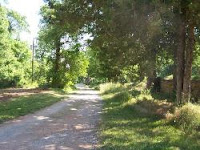 |
| View into Cove Creek Valley |
Having learned of the presence of three small brigades of Confederate cavalry at what is now Canehill (the name has been condensed over the years from the original Cane Hill), Union General James G. Blunt moved south on November 27, 1862, to attack them with his division of the Army of the Frontier. It was a desperate forced march made through difficult conditions. The Union army camped north of Cane Hill that night and then continued the movement forward early on the morning of the 28th.
As General Blunt later reported, he sent spies into the Confederate lines to determine the strength of their position. They returned to report that the main road leading into Cane Hill was well posted with sentries. Despite rough conditions, the Federals pushed forward on the morning of November 28, 1862, and attacked at 10 a.m. with barrages of artillery.
The severely outnumbered Confederates responded with their own guns and the fields and hills shook with the sound of cannon fire that echoed off the Boston Mountains to the south and washed over the farms, villages and towns of Washington and Benton Counties in Northwest Arkansas.
Moving around to his right to use a little known road, Blunt struck the left of the Confederate line. The Southern troops were commanded by General John S. Marmaduke and the first Confederates encountered by Blunt were led by the famed general from missouri, "Fighting Jo" Shelby.
 |
| Ambush Site on Cove Creek Road |
From the villages across the ridge of Rich Mountain and down into the valley of Cove Creek the fighting continued, until as darkness fell it appeared the Confederates had withdrawn. Union cavalry surged forward down the Cove Creek road, hoping to hit the retreating Confederates from behind, but instead rode directly into an ambush prepared by Marmaduke. Fire erupted from their front and flanks, dropping soldiers from their soldiers and forcing the Federals into a mad retreat.
It was not long after this that a truce was declared to collect the dead and wounded and the fighting finally came to an end. Blunt had taken his objective, but it had required a day of hard fighting against a much smaller force. Marmaduke had not given way easily.
You can learn more about the battle at www.exploresouthernhistory.com/ARCaneHill. I'll have more on the effects of the Battle of Cane Hill and its role in the coming Battle of Prairie Grove soon.

